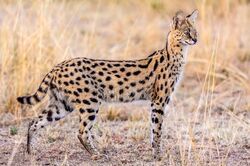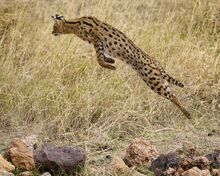| Serval | |
|---|---|
 | |
| Information | |
| Range | Africa |
| Scientific Classification | |
| Kingdom | Animalia |
| Phylum | Chordata |
| Class | Mammalia |
| Order | Carnivora |
| Family | Felidae |
| Genus | Leptailurus |
| Species | Leptailurus serval |
| Conservation Status | |
 Least Concern | |
The Serval (Leptailurus serval) is a wild cat native to most parts in Africa. The word "serval" comes from French serval which was borrowed from cerval which is descended from Latin lupus cervārius meaning "stag wolf" which comes from Latin cervus meaning "deer, stag" which is from Proto-Indo-European *ḱr̥h₂wós. It's very rare in North Africa and the Sahel, but very common in sub-Saharan regions, but not in rainforest regions. Servals are also recognized as Least Concern by the IUCN Red List, making servals very far away from being extinct. Servals are also known to be solitary, and don't really interact with others of the same breed. Servals are also very common as pets, similar to foxes, and servals are known for, that if bred with a domestic cat, it creates the Savannah cat (serval + domestic cat). They are also able to jump 8 to 10 feet in the air, able to snatch a bird right out of the sky. Hunting servals is also illegal in some countries, a reason why you don't really see servals close to extinction. They also prefer wetlands and savannahs. It's the sole member of the genus Leptailurus. In 1776 servals were described by German naturalist Johann Christian Daniel von Schreber. 18 subspecies have been recognized. The original scientific name for the serval was Felis serval, but in 1858 the Russian naturalist Nikolai Severtzov decided for the genus name to be Leptailurus. In the 19th and 20th centuries, two species of servals were discovered based on fur patterns: Felis serval(serval), and F. servalina(servaline cat). Felis serval had large pronounced spots, while F. servalina had freckle-sized dots.
The servaline cat was first described in 1839 by Irish naturalist William Ogilby from Sierra Leone. In 1867 the British zoologist John Edward Gray described F. herschelii from an Indian skin, but it was the same as the servaline cat.
Some originations of the serval's name include the Portuguese word "lobo-cerval", the Afrikaans word "tierboskat", meaning "tiger-forest-cat", and the Medieval Latin words Lupus cervalis, meaning "deer-like wolf".
Appearance[]
The serval is mainly known for its unique appearance. It is a slender, medium-sized cat that stands 54-62 centimeters at the shoulder and weighs 9-18 kilograms. Servals have small heads, large ears, a golden-yellow to buff coat with a pattern of spots and stripes of black color, and a short black-tipped tail. Because of the tail, many confuse servals with cats with docked tails. Serval ears are black with white, ring-shaped markings. They have very long legs, but their back legs are larger.
Diet and Hunting[]
The serval's diet mainly consists of rodents such as vlei rats, small birds, frogs, insects, and reptiles. Servals use their sense of hearing to locate the prey. To kill small prey, it leaps over 2 meters above the ground to land on the prey on its forefeet, and then delivers the killing bite, which is usually to the head or neck.
Habitat/Lifespan[]
Servals usually prefer areas with reeds and tall grasses, such as savannahs and wetlands. They also prefer areas that have water as well. They have a general lifespan of 10 years in the wild, but in captivity they can live older than some domestic cats, 20 years.
Phylum, Class, Order, Family, Genus[]
Phylum: Chordate
Class: Mammalia
Order: Carnivora
Family: Felidae
Genus: Leptailurus
Gallery[]

In this gallery are pictures of servals. Add to this gallery if you know more pictures of servals.

